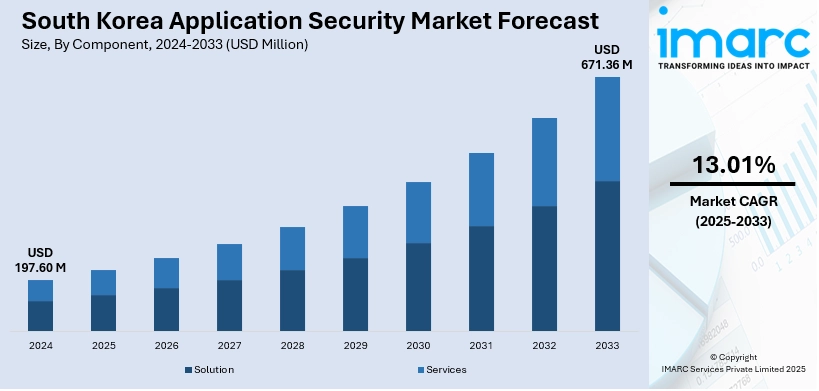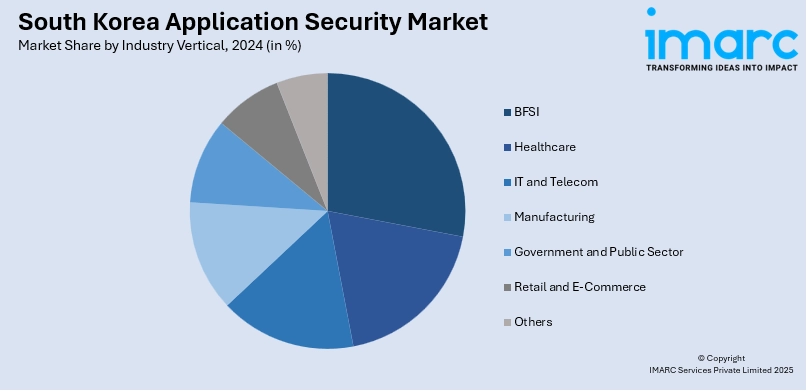
South Korea Application Security Market Size, Share, Trends and Forecast by Component, Type, Testing Type, Deployment Mode, Organization Size, Industry Vertical, and Region, 2025-2033
South Korea Application Security Market Overview:
The South Korea application security market size reached USD 197.60 Million in 2024. The market is projected to reach USD 671.36 Million by 2033, exhibiting a growth rate (CAGR) of 13.01% during 2025-2033. At present, rising number of cyberattacks is increasing the urgency for businesses to protect their digital assets and applications, driving the demand for application security solutions. In addition, the growing utilization of artificial intelligence (AI), which aids in enabling faster, smarter, and more accurate threat detection and response, is contributing to the expansion of the South Korea application security market share.
|
Report Attribute
|
Key Statistics
|
|---|---|
|
Base Year
|
2024
|
|
Forecast Years
|
2025-2033
|
|
Historical Years
|
2019-2024
|
| Market Size in 2024 | USD 197.60 Million |
| Market Forecast in 2033 | USD 671.36 Million |
| Market Growth Rate 2025-2033 | 13.01% |
South Korea Application Security Market Trends:
Increasing number of cyberattacks
Rising number of cyberattacks is positively influencing the market in South Korea. As per industry reports, from April to June 2025, 3 major breaches highlighted the extent of South Korea's cybersecurity weaknesses. In April 2025, SK Telecom disclosed that malware remained unnoticed on its servers for almost three years, ultimately compromising 9.82 Gigabytes of customer data, approaching 27 Million IMSI records. With an increasing number of organizations transitioning to online operations and utilizing digital platforms, the likelihood of cyber threats, including data breaches, ransomware, and malware attacks, is escalating swiftly. Cybercriminals are focusing on applications to take advantage of weak points and obtain unauthorized access to confidential data. This increasing danger is motivating companies in fields, such as finance, healthcare, retail, and government, to heavily invest in application security measures. Organizations are utilizing sophisticated tools like firewalls, encryption, multi-factor authentication, and vulnerability scanners to protect their applications during both the development and post-deployment phases. Application security is increasingly important in software development cycles, backed by methods, including DevSecOps and secure coding practices. Regulatory compliance demands are driving companies to adopt strong security frameworks to prevent penalties and damage to their reputation. Moreover, rising usage of mobile applications and cloud services is generating new vulnerabilities, making ongoing security oversight and threat identification essential. With cyberattacks growing increasingly complex and common, the demand for proactive and unified application security solutions is high.

To get more information on this market, Request Sample
Rising utilization of AI
Increasing integration of AI is fueling the South Korea application security market growth. As per the IMARC Group, the South Korea AI market size reached USD 3.12 Billion in 2024. AI enhances application security through the real-time analysis of extensive data sets, detection of unusual patterns, and prediction of potential vulnerabilities before they can be exploited. This allows organizations to respond proactively rather than reactively to cyber threats. AI-based tools, such as behavioral analytics, machine learning (ML) algorithms, and automated response systems, help in reducing false positives and improving the overall efficiency of security operations. As applications become more complex and interconnected through cloud services and mobile platforms, AI aids in managing and monitoring these layers with greater precision. In South Korea, where digital transformation is rapidly progressing, businesses across industries are adopting AI-based security tools to protect their applications and ensure data integrity. The utilization of AI is also supporting continuous monitoring and self-learning security systems, which adapt to evolving threats. This integration is not only strengthening the overall cybersecurity landscape but also stimulating the growth of the market by offering scalable, intelligent, and cost-effective protection solutions.
South Korea Application Security Market Segmentation:
IMARC Group provides an analysis of the key trends in each segment of the market, along with forecasts at the country and regional levels for 2025-2033. Our report has categorized the market based on component, type, testing type, deployment mode, organization size, and industry vertical.
Component Insights:
- Solution
- Services
The report has provided a detailed breakup and analysis of the market based on the component. This includes solution and services.
Type Insights:
- Web Application Security
- Mobile Application Security
A detailed breakup and analysis of the market based on the type have also been provided in the report. This includes web application security and mobile application security.
Testing Type Insights:
- Static Application Security Testing (SAST)
- Dynamic Application Security Testing (DAST)
- Interactive Application Security Testing (IAST)
- Runtime Application Self-Protection (RASP)
The report has provided a detailed breakup and analysis of the market based on the testing type. This includes static application security testing (SAST), dynamic application security testing (DAST), interactive application security testing (IAST), and runtime application self-protection (RASP).
Deployment Mode Insights:
- On-premises
- Cloud-based
A detailed breakup and analysis of the market based on the deployment mode have also been provided in the report. This includes on-premises and cloud-based.
Organization Size Insights:
- Large Enterprises
- Small and Medium-sized Enterprises
The report has provided a detailed breakup and analysis of the market based on the organization size. This includes large enterprises and small and medium-sized enterprises.
Industry Vertical Insights:

- BFSI
- Healthcare
- IT and Telecom
- Manufacturing
- Government and Public Sector
- Retail and E-Commerce
- Others
A detailed breakup and analysis of the market based on the industry vertical have also been provided in the report. This includes BFSI, healthcare, IT and telecom, manufacturing, government and public sector, retail and e-commerce, and others.
Regional Insights:
- Seoul Capital Area
- Yeongnam (Southeastern Region)
- Honam (Southwestern Region)
- Hoseo (Central Region)
- Others
The report has also provided a comprehensive analysis of all the major regional markets, which include Seoul Capital Area, Yeongnam (Southeastern Region), Honam (Southwestern Region), Hoseo (Central Region), and others.
Competitive Landscape:
The market research report has also provided a comprehensive analysis of the competitive landscape. Competitive analysis such as market structure, key player positioning, top winning strategies, competitive dashboard, and company evaluation quadrant has been covered in the report. Also, detailed profiles of all major companies have been provided.
South Korea Application Security Market News:
- In October 2024, Kaspersky revealed the launch of ‘Transparency Center’ in Seoul, South Korea, reinforcing its dedication to providing top security assurance for its offerings and services. During a Transparency Center visit, the company’s secure software development documentation, encompassing threat analysis, application security testing procedures, and the ‘Software Bill of Materials’, could also be reviewed.
South Korea Application Security Market Report Coverage:
| Report Features | Details |
|---|---|
| Base Year of the Analysis | 2024 |
| Historical Period | 2019-2024 |
| Forecast Period | 2025-2033 |
| Units | Million USD |
| Scope of the Report |
Exploration of Historical Trends and Market Outlook, Industry Catalysts and Challenges, Segment-Wise Historical and Future Market Assessment:
|
| Components Covered | Solution, Services |
| Types Covered | Web Application Security, Mobile Application Security |
| Testing Types Covered | Static Application Security Testing (SAST), Dynamic Application Security Testing (DAST), Interactive Application Security Testing (IAST), Runtime Application Self-Protection (RASP) |
| Deployment Modes Covered | On-premises, Cloud-based |
| Organization Sizes Covered | Large Enterprises, Small and Medium-sized Enterprises |
| Industry Verticals Covered | BFSI, Healthcare, IT and Telecom, Manufacturing, Government and Public Sector, Retail and E-Commerce, Others |
| Regions Covered | Seoul Capital Area, Yeongnam (Southeastern Region), Honam (Southwestern Region), Hoseo (Central Region), Others |
| Customization Scope | 10% Free Customization |
| Post-Sale Analyst Support | 10-12 Weeks |
| Delivery Format | PDF and Excel through Email (We can also provide the editable version of the report in PPT/Word format on special request) |
Key Questions Answered in This Report:
- How has the South Korea application security market performed so far and how will it perform in the coming years?
- What is the breakup of the South Korea application security market on the basis of component?
- What is the breakup of the South Korea application security market on the basis of type?
- What is the breakup of the South Korea application security market on the basis of testing type?
- What is the breakup of the South Korea application security market on the basis of deployment mode?
- What is the breakup of the South Korea application security market on the basis of organization size?
- What is the breakup of the South Korea application security market on the basis of industry vertical?
- What is the breakup of the South Korea application security market on the basis of region?
- What are the various stages in the value chain of the South Korea application security market?
- What are the key driving factors and challenges in the South Korea application security market?
- What is the structure of the South Korea application security market and who are the key players?
- What is the degree of competition in the South Korea application security market?
Key Benefits for Stakeholders:
- IMARC’s industry report offers a comprehensive quantitative analysis of various market segments, historical and current market trends, market forecasts, and dynamics of the South Korea application security market from 2019-2033.
- The research report provides the latest information on the market drivers, challenges, and opportunities in the South Korea application security market.
- Porter's five forces analysis assist stakeholders in assessing the impact of new entrants, competitive rivalry, supplier power, buyer power, and the threat of substitution. It helps stakeholders to analyze the level of competition within the South Korea application security industry and its attractiveness.
- Competitive landscape allows stakeholders to understand their competitive environment and provides an insight into the current positions of key players in the market.
Need more help?
- Speak to our experienced analysts for insights on the current market scenarios.
- Include additional segments and countries to customize the report as per your requirement.
- Gain an unparalleled competitive advantage in your domain by understanding how to utilize the report and positively impacting your operations and revenue.
- For further assistance, please connect with our analysts.
 Request Customization
Request Customization
 Speak to an Analyst
Speak to an Analyst
 Request Brochure
Request Brochure
 Inquire Before Buying
Inquire Before Buying




.webp)




.webp)












